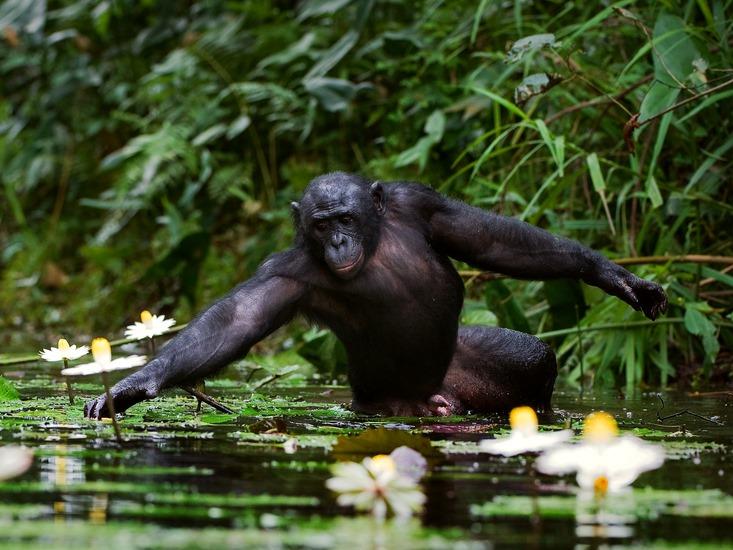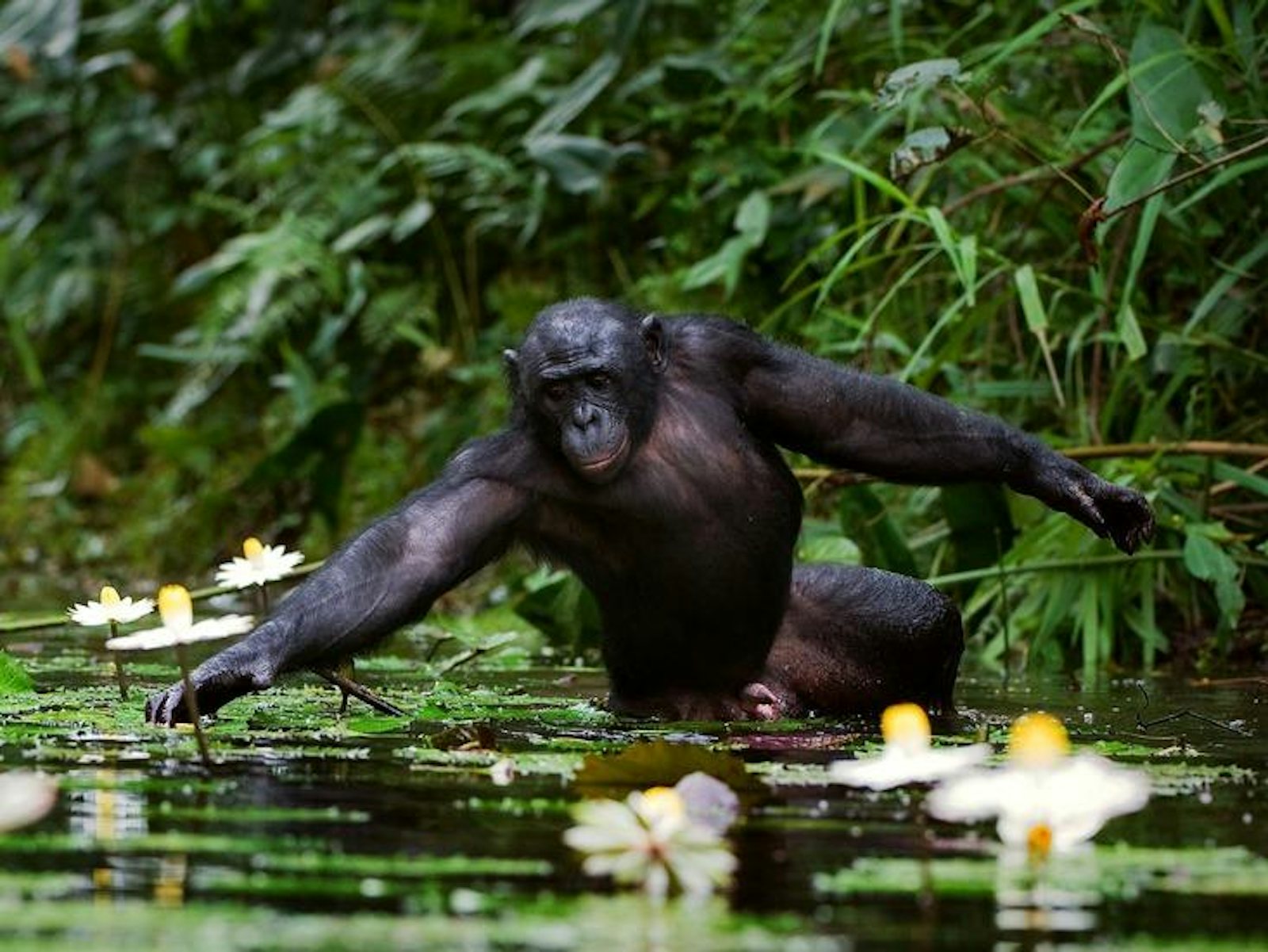There is a waterfall in Tanzania’s Gombe National Park. Maybe 12 feet high, it’s fairly modestly sized, though even a modest waterfall is quite a magical thing. And it’s here that chimpanzees come to dance.
You can watch a video online, narrated by the great primatologist Jane Goodall, who, as with so many chimpanzee behaviors, was the first to observe these rituals. It’s quite a show: An adult male approaches via the riverbed with a slow, rhythmic gait, so unlike yet like our own. He throws rocks and tree branches into the falls, then catches a vine and swings above them. Finally he sits on a rock in the stream, head resting on forearms, and watches the water go by.

These performances happen several times each year, but they do not have any obvious utilitarian purpose, even as social displays; though groups of chimps sometimes participate, often it’s just a solitary individual. Given how easily a chimp might slip on the rocks, it’s quite risky. Chimps also can’t swim, and typically avoid running water. Which raises the question: What are these chimps thinking?
“I can’t help feeling that this waterfall display, or dance, is perhaps triggered by feelings of awe and wonder,” says Goodall in the video. “The chimpanzee brain is similar to ours. They have emotions that are clearly similar to those that we call happiness and sadness and fear and despair and so forth. So why wouldn’t they also have feelings of some kind at spirituality? Which is, really, being amazed at things outside yourself.”
In which case: spiritual chimps.
It’s been a hard notion for some to accept. Theologian Christopher Fisher argued Goodall was anthropomorphizing her subjects—interpreting an animal’s behavior in inappropriately human-centered terms—and that only humans can be spiritual. While Fisher’s refutation could just as easily be dismissed as yet another example of anthropocentrism, assuming that what’s important to humans is also what’s singular about us, he raises a fair point: We don’t know what’s happening in a rain-dancing chimp’s mind.
Then again, if you want to get philosophical about it, we can’t really know what’s going on in each others’ minds, either. We just weigh evidence and make inferences and put together some subjective but educated guesses. And this we do know about chimps: They possess the cognitive capacities—the ability to think symbolically and use imagination, and to learn through imitation—that underlie human ritual and spirituality.
“Perhaps it is a ritual of respect or abnegation to the god of water,” writes primatologist William McGrew in The Cultured Chimpanzee. This is, he cautions, a speculation that can’t be tested. It’s also possible that the chimps use the waterfall and its predictable stimulus—“Can anyone not stand at the base of a waterfall without their pulse racing?” asks McGrew—as a setting to practice displays of bravado typically expressed in confrontations with other chimps. Sparring practice, essentially.
“I think chimpanzees are as spiritual as we are, but they can’t analyze it.”
Mary Lee Jensvold, a primatologist and former director of the Chimpanzee and Human Communication Institute, offered her own thoughts. Like McGrew, she posited an alternative explanation: various loud stimuli, including machinery and boisterous people, can elicit chimpanzee displays. Yet what “makes me think this is something deeper,” says Jensvold, “is the sitting quietly and staring at the waterfall afterwards.”
That’s what gets me, too. A chimp just sitting with his or her thoughts. Contemplating the water, much in the manner I do at streamside. I know where the water comes from, the planetary cycles and local ecologies, and it’s still magical current of time and life. Sometimes I say a thank-you. What might water evoke in a being capable of rich abstraction, eminently aware of water’s vitality, but with a different and less mechanistic body of knowledge? Suddenly it doesn’t seem so far-fetched to imagine chimps experiencing some seed of what, in Homo sapiens, eventually grew into water myths found in just about every human society. Spirituality in its elemental form is pretty simple. Like Goodall says, it’s being amazed at things outside yourself.
“I think chimpanzees are as spiritual as we are, but they can’t analyze it,” Goodall says in the video. “You get the feeling that it’s all locked up inside them, and the only way they can express it is through this fantastic rhythmic dance.” Maybe these waterfall dances—and also similar dances she’s observed at the start of sudden, seasonal downpours—will someday give rise to animistic proto-religion, imbuing falling water with existential meaning. Perhaps they already have.
What about other nonhuman primates? I asked UCLA anthropologist Susan Perry, who studies capuchin monkeys. Sometimes they perform dances otherwise conducted during courtship when the first rains come after dry season, she said. It doesn’t happen every year, though, and Perry doesn’t think it displays spiritual wonder or awe. In a similar vein, anthropologist Laurie Santos of Yale University reports nothing comparable from her rhesus monkey observations.
This would seem to fit with what’s known of monkey cognition: They do think in complex ways, and certainly possess some elaborate interpersonal rituals, but they’re not quite so abstract-minded as chimps. Outside of primates, though, plenty of species have the mental potential. Quite a few cetaceans, for example, including orcas with their remarkable tribal greeting ceremonies. Ditto elephants and their burial rites. Again: we can’t know what they’re thinking, but it’s unscientific not to consider the possibility. “Perhaps numerous animals engage in these rituals,” writes ethologist Marc Bekoff in The Emotional Lives of Animals, “but we haven’t been lucky enough to see them.”
And what else might be going on with chimpanzees? One particular report, published several years ago in the American Journal of Physical Anthroplogy, catches my imagination. In it researchers describe a group of chimps living at Fongoli, Senegal, in a savanna reminiscent of settings where the earliest humans evolved. The chimps, wrote the researchers, often dance at the edge of fires.
Brandon Keim is a freelance journalist who writes about science, technology, and nature. His work has appeared in Wired, Aeon, Scientific American Mind, and other publications.


























